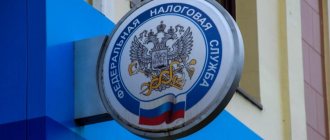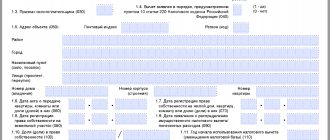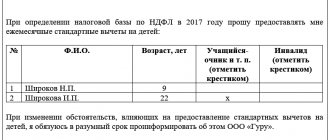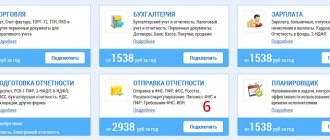What is an investment tax deduction
The uniqueness of the investment tax deduction (hereinafter referred to as INV, deduction) is that for the first time in the practice of profit taxation, the legislator allowed to reduce not the tax base, but directly the amount of tax payable, by the amount of expenses incurred by the taxpayer. Thus, the tax amount can be reduced not by 20% of certain types of expenses incurred, but by the full amount of such expenses. However, there are some limitations:
- the amount of INV not used in the current tax period cannot always be transferred to the future;
- in some cases, the entire amount of the previously used deduction will have to be restored with additional payment of tax and penalties.
General provisions
The investment tax deduction for income tax (IIT) was introduced on January 1, 2018. A separate article of the Tax Code of the Russian Federation is devoted to it - 286.1.
IVP is that an enterprise can reduce income tax payments by the amount of investment, i.e. for the amount of purchase or modernization of fixed assets.
The use of TRP is limited in time until January 1, 2028.
The Code in this case establishes only the “framework” within which the investment income tax deduction is applied; regions within these limits can independently determine its parameters. Until the corresponding regional law is adopted, the IVP is not applied in this subject of the Russian Federation.
Below we will consider the “federal” indicators for calculating the TPI.
Conditions for applying the investment tax deduction
The use of INV is a taxpayer’s right, not an obligation. To do this, you need to include a corresponding provision in the accounting policy for tax purposes (clause 8 of Article 286.1 of the Tax Code of the Russian Federation). We list the main conditions for applying the deduction.
1. The deduction is applied in relation to:
- expenses for the acquisition of fixed assets, their construction, production, delivery and bringing them to a condition in which they are suitable for use;
- expenses for their completion, additional equipment, reconstruction, modernization, etc.
Used in accordance with the norm of clause 2 of Art. 286.1 of the Tax Code of the Russian Federation, the construction “and (or)” allows us to assume that the taxpayer can choose whether to apply an INV in relation to only one of the two listed groups of expenses or in relation to expenses of all types. However, here it is better to wait for official clarification.
2. The deduction is applied to all expenses incurred related to fixed assets included in depreciation groups 3–7, and to all fixed assets.
3. The deduction is applied only if the regional law introduces the possibility of its use. At the same time, a subject of the Russian Federation may limit the right to use INV in relation to certain categories of taxpayers and (or) in relation to certain categories of fixed assets.
4. In any case, the deduction cannot be applied by consolidated groups of taxpayers, as well as participants in regional investment projects and other persons specified in clause 11 of Art. 286.1 Tax Code of the Russian Federation.
5. The decision made to use a deduction or to refuse to use it can be changed no earlier than three years later, unless a different period is established by regional law. It is impossible to refuse to use the INV before the established deadline.
Quickly and accurately determine the depreciation group in the OKOF directory
To learn more
Conditions for receiving an investment deduction
To obtain the right to a deduction, both the taxpayer himself and his fixed assets must meet a number of mandatory requirements.
The taxpayer must:
- be in a region where a law on investment tax deduction has been adopted;
- decide on the use of investment deduction;
- reflect the decision on the use of investment deduction in the accounting policy of the organization;
- operate the fixed assets for which the deduction was received throughout their entire useful life;
- be absent from the federal and regional list of payers who are not entitled to an investment deduction.
Fixed assets must be:
- fixed on the balance sheet of the organization or its separate divisions;
- assigned to the third to seventh depreciation groups;
- put into operation starting January 1, 2021;
- excluded from depreciable fixed assets.
These are the basic requirements for taxpayers and fixed assets established by the Tax Code of the Russian Federation. At the regional level, additional requirements may be imposed on them.
The mechanism for applying the deduction
Immediately after the tax period, the entire calculation is actually performed anew each time, since the amount of tax (advance payments) is considered a cumulative total.
Step 1. Determine the amount of expenses included in the deduction
This amount will be equal to the amount of expenses for acquisition (construction, etc.) and (or) modernization (reconstruction), etc. fixed assets in respect of which INV can be used for the reporting (tax) period. In what follows, we will call this amount the “amount of investment expenses.”
Step 2. Determine the amount that applies to the reduction of “federal” income tax
This amount is 10% of the expenses determined in step 1, but not more than the amount of tax payable to the federal budget. The difference between the amount by which income tax is actually reduced and 10% of the amount of investment expenses cannot be used in subsequent tax periods.
For example, the amount of investment expenses of the organization for 2021 amounted to 3 million rubles. At the end of the year, the tax payable to the federal budget was determined in the amount of 270 thousand rubles. In this case, the amount of the deduction that reduces the tax in the “federal” part will be only 270 thousand rubles. A deduction in the amount of 30 thousand rubles (3 million rubles × 10% - 270 thousand rubles) cannot be used; these expenses will “disappear” for income tax.
Step 3. Determine the maximum deduction amount for the “regional” income tax
For income tax payable to the budget of a constituent entity of the Russian Federation, the maximum deduction amount is determined as follows:
| Limit value of deduction (MPV) | = | Tax at the rate established by the Tax Code of the Russian Federation | – | Tax at 5% rate |
Note that a subject of the Russian Federation, when introducing an investment tax deduction, can establish a different (different from 5%) tax rate for calculating the maximum deduction amount.
Step 4. Determine the amount of deduction that applies to reducing the “regional” income tax
The amount that reduces the tax payable to the budget of a constituent entity of the Russian Federation is 90% of the amount of investment expenses. The deduction amount (in the “regional” part) transferred from previous periods is also added to this value. In this case, the tax can be reduced by no more than PPV.
For example, the amount of investment expenses of the organization for 2021 amounted to 5 million rubles. At the end of the year, the tax base amounted to 30 million rubles, PIT = 30 million rubles × 17% – 30 million rubles × 5% = 3.6 million rubles. The “regional part” of the INV will amount to 90% of investment expenses, that is, 5 million rubles × 90% = 4.5 million rubles.
This means that in 2021, the amount of tax payable to the budget of a constituent entity of the Russian Federation will be reduced by 3.6 million rubles and amount to 1.5 million rubles (30 million rubles × 17% - 3.6 million rubles). The balance of the “regional deduction” in the amount of 4.5 – 3.6 = 0.9 (RUB million) can be transferred to 2021 and subsequent years of application of the deduction.
Calculation example
In October 2021, Beta LLC acquired and put into operation a production line (4th depreciation group) worth 15,000 thousand rubles. Its useful life is 61 months. In February 2019, a machine worth 2,500 thousand rubles was purchased. Its useful life is also 61 months. There were no other investment expenses in 2021 and in the first quarter of 2021.
In the constituent entity of the Russian Federation in which Beta LLC is registered, a law has been passed allowing the use of investment tax deductions. The maximum deduction amount (for “regional” tax) is calculated using a rate of 5%. The Company calculates monthly advance payments based on the actual profit received.
The tax base is determined by the organization in the following amounts:
- for January - September 2021 - 43,000 thousand rubles;
- for January - October 2021 - 46,000 thousand rubles;
- for January - November 2021 - 51,000 thousand ₽;
- for 2021 as a whole - 58,000 thousand rubles;
- for January 2021 - 2,000 thousand rubles;
- for January - February 2021 - 16,000 thousand rubles;
- for January - March 2021 - 23,000 thousand rubles.
The calculation of the amount of investment expenses that reduce tax (advance payments) and the amount of tax (advance payments) payable in each of its parts for the named periods is given in tables 1 and 2.
Table 1. Tax base, tax amounts and investment expenses, thousand rubles
Table 2. Calculation of tax-reducing expenses (advance payments) and tax amounts (advance payments) payable, thousand rubles
Let's give a brief explanation.
There were no investment expenses for the period January - September 2021 This means that the amounts of advance payments (cumulative total) for the period will be, respectively, 1,290 thousand rubles (43,000 thousand rubles × 3%) to the federal budget and 7,310 thousand rubles (43,000 thousand rubles × 17% ) to the budget of a constituent entity of the Russian Federation.
During the period January - October 2021, investment expenses in the amount of 15,000 thousand rubles were made. Of these, the tax payable to the federal budget can be reduced by 1,500 thousand rubles, and the tax payable to the budget of a constituent entity of the Russian Federation by 13,500 thousand rubles. In fact, the tax is reduced only in an amount not exceeding the maximum amount.
Thus, the tax (advance payment) payable to the federal budget at the end of 10 months of 2021 is reduced by 1,380 thousand rubles - to zero. All advance payments previously paid in 2021 become overpaid (and may be returned or offset in the general manner). Expenses in the amount of 120 thousand rubles in this reporting period cannot be used to reduce federal tax.
The tax (advance payment) payable to the regional budget, based on the results of 10 months of 2021, is reduced by 5,520 thousand rubles and will amount to 2,300 thousand rubles. Expenses in the amount of 7,980 thousand rubles remain unused.
For the period January – November 2018, the amount of investment expenses does not change, but the tax base increases, and therefore the possible amount of tax reduction (advance payments). Based on the results of this reporting period, expenses in the “federal” part will be used in full - in the amount of 1,500 thousand rubles, and the tax (advance payment) payable to the federal budget will be 30 thousand rubles (1,530 thousand rubles - 1,500 thousand ₽). The tax (advance payment) to the regional budget will decrease by 6,120 thousand rubles and amount to 2,550 thousand rubles (8,670 thousand rubles – 6,120 thousand rubles).
For 2021, as a whole, the amount of investment expenses remains the same, but the amount of reduction in the “regional” tax increases (investment expenses in the federal part have already been fully used). At the end of the year (tax period), the tax payable to the federal budget will be 240 thousand rubles (1,740 thousand rubles – 1,500 thousand rubles). The tax to the regional budget will decrease by 6,960 thousand rubles and amount to 2,900 thousand rubles (9,860 thousand rubles – 6,960 thousand rubles). The amount of investment expenses not used in 2021 in the amount of 6,540 thousand rubles (13,500 thousand rubles - 6,960 thousand rubles) is carried over to the following tax periods.
For the first reporting period (January) 2021, Beta LLC had no investment expenses. Therefore, the tax (advance payment) to the federal budget must be paid in the full calculated amount - 60 thousand rubles. But in the regional part, the advance payment can be reduced by investment expenses carried over from last year, but again no more than to the minimum amount determined by law. Thus, the “regional” tax (advance payment) is reduced by 240 thousand rubles and amounts to 100 thousand rubles.
During the period January - February 2021, investment expenses in the amount of 2,500 thousand rubles were made. Therefore, the “federal” advance payment is reduced by 250 thousand rubles and amounts to 230 thousand rubles (in the “federal” part, investment expenses will be used in full). The “regional” advance payment is reduced by 1,920 thousand rubles and amounts to 800 thousand rubles, while it will not be possible to use the expenses carried over from last year for this reporting period as a whole (since the tax is calculated on an accrual basis).
In this situation, another logic is possible (we marked these values with * in the table). Since part of the “transferred” expenses was already used in the previous reporting period, there is no reason to reduce this used part. However, in this case, the amount of expenses of the current period that reduce the tax (advance payment) will decrease by the same amount, that is, the amount of tax (advance payment) payable in any case will not be less than 5% of the tax base, and the unused amount will still be transferred for the future. In other words, the final result for any version of the reasoning will be the same, only the distribution of the used deduction between specific fixed assets, which is important for the early disposal of fixed assets, will be different.
The specific procedure for using investment expenses must be determined in the accounting policy for tax purposes.
Nevertheless, it seems that the more correct option is the one reflected in the table: by analogy with the transfer of losses to the future, all investment expenses of the current period are first used, and only then the remainder of the deduction carried forward from previous years.
For the period January - March 2021, the amount of investment expenses does not change, but the amount of the “regional” tax reduction also increases. The advance payment payable to the federal budget will be 440 thousand rubles (690 thousand rubles – 250 thousand rubles). Expenses accepted to reduce the “regional” advance payment will amount to 2,760 thousand rubles, including 2,250 thousand rubles of expenses of the current period and 510 thousand rubles from the amount transferred from 2018. Thus, the advance payment payable to the budget of the constituent entity of the Russian Federation at the end of the reporting period will amount to 1,150 thousand rubles.
The mechanism of the deduction
The time frame is as follows: the new investment deduction for income tax can be applied and abandoned only from the beginning of the year. This decision is allowed to be changed once every three years (unless the subject of the Russian Federation has prescribed a different period).
As a general rule, the value of the investment deduction is such that due to the tax/advance payment on it, which goes to the regional treasury, in the current period you can write off up to 90% of the costs that affect the initial cost of the fixed asset (except in cases of liquidation). Although the region can lower this bar at its discretion.
In addition, there is a deduction limit that cannot be exceeded for the current period. You can only transfer the rest of it to the future.
The formula for the maximum amount of the new deduction is as follows:
| Tax to the regional budget, calculated according to general rules for the tax (reporting) period MINUS Tax to the regional budget, calculated according to general rules for the tax (reporting) period × rate of 5% (unless a different rate is established by the constituent entity of the Russian Federation) |
Consequences of using investment deduction
It is important that fixed assets for which a deduction is applied cannot be subject to depreciation, nor can a “depreciation bonus” be applied to the corresponding part of the expenses. This prohibition applies even if the deduction reduced the amount of tax (advance payment) payable only partially or did not reduce it at all.
Example 1
Alpha LLC applied INV in relation to expenses for the acquisition of fixed assets. In fact, only part of the cost of acquiring fixed assets was used to reduce the tax payable.
Regardless of this, the remaining costs for the acquisition of this fixed asset cannot be subject to depreciation or a depreciation bonus.
If in the future this fixed asset is modernized and the costs of modernization are not included in the INV (for example, by this time Alpha LLC will refuse to apply the deduction), then the costs of modernization can be amortized, and it will also be possible to apply in relation to such expenses depreciation bonus.
If modernization expenses are also included in the INV (regardless of whether these expenses will reduce the amount of tax, and if they do, then to what extent), then the calculation of depreciation and the application of a depreciation bonus will be impossible for modernization expenses.
Example 2
Gamma LLC applied the INV in relation to the costs of modernizing a fixed asset; no deduction was applied to the costs of its acquisition.
In this situation, the fixed asset continues to be depreciated in relation to the acquisition costs (that is, in fact, in the same manner, as if there had been no modernization), and for modernization costs one can neither apply a depreciation bonus nor accrue depreciation.
Let us also briefly mention other consequences of applying the deduction.
1. During a desk tax audit of a declaration in which the application of a deduction is stated, the tax authority has the right to demand explanations or documents confirming the legality of the application of the deduction (clause 8.8 of Article of the Tax Code of the Russian Federation). Let us remind you that in general, it is possible to demand explanations during a desk audit only in a strictly limited number of cases, and you cannot demand documents at all.
2. The threshold for recognizing transactions between related parties as controlled is reduced: if at least one of the parties applies a deduction, then it is enough that the total amount of transactions exceeds 60 million rubles (in the general case 1 billion rubles; clauses 1, 9, clause 2, article 105.14 Tax Code of the Russian Federation).
How to refuse to use INV?
You can refuse the INV only after three years from the date you started using the deduction. Refusal to use INV is also allowed only from the beginning of the next tax period.
That is, the taxpayer has the right to change a previously made decision on the use (or refusal to use) INV after three consecutive tax periods of application of such a decision.
Subjects of the Russian Federation are given the right to determine a different period permissible for canceling a decision on the use (non-use) of an INV.
Restoration of investment deduction
If an organization sells a fixed asset for which it used an investment deduction before the end of its useful life, then it is necessary to restore the amount of tax underpaid in connection with the use of the deduction and pay it to the budget with penalties. The same must be done for any other disposal of fixed assets, except for liquidation.
Penalties are calculated from the day following the due date for payment of the underpaid tax.
Let us note that in the norm (clause 12 of Article 286.1 of the Tax Code of the Russian Federation) we are talking specifically about tax, but not about advance payment, that is, the underpaid amount of tax is determined only at the end of the year (tax period), and not reporting periods.
Distribution of deductions between OS when it is not fully used
As we see, upon early disposal of a fixed asset, the underpaid tax, subject to additional payment, is determined only for this object. This means that the taxpayer needs to keep records of investment expenses that reduce the amount of tax paid for each fixed asset separately.
If the costs of purchasing or upgrading the OS are fully used to reduce the tax, then there is no problem with determining the amount to be restored and additionally paid. But what if they are not fully used and are taken into account across several OS objects at once?
The Tax Code of the Russian Federation does not establish any procedure for this case, so the taxpayer needs to develop it independently and consolidate it in the accounting policy for tax purposes. It seems that there are two possible options here:
1. Distribute amounts among all fixed assets for which the deduction is used, in proportion to their value. We believe that this option carries the least risk of claims from the tax authority; it does not raise questions from the point of view of economic sense and logic.
2. Use investment expenses to reduce taxes sequentially on fixed assets, that is, assume that while one fixed asset is not fully “covered”, expenses on others are not used at all. However, this option seems less logical, since in this case the requirement of paragraph 8 of Art. 286.1 of the Tax Code of the Russian Federation: investment deduction applies to all fixed assets.
Use the search by regional legislation and find out whether the investment deduction can be applied in your region
To learn more
The role of regional authorities
In general, the Tax Code does not fully regulate investment tax deductions. The resolution of many issues is left to the discretion of the constituent entities of the Russian Federation.
For example, regional authorities should introduce this deduction on their territory. And it’s not a fact that they will do it.
In addition, the region may put forward its own conditions for using the new deduction. For example, which categories of payers cannot use it. Although the general rules are still spelled out in Art. 286.1 of the Tax Code of the Russian Federation and the subjects of the Russian Federation cannot go across them.
To use or not to use
In conclusion, we will try to answer the question when the use of INV is beneficial, and when it is better to use the traditional mechanism in the form of depreciation. Of course, the deduction makes it possible to obtain a tax benefit in a larger amount than “classical” depreciation. However, this is only true when the organization pays significant amounts of income tax.
In other words, if an organization’s income is almost equal to its expenses or even there are losses in tax accounting, the application of an investment deduction will be impossible, the organization will simply “lose” the costs of purchasing (upgrading) the OS. Thus, the use of an investment deduction makes sense only when there is a sufficient tax base for this and, accordingly, the amount of tax to be paid.
What to do if an OS object is sold?
If, before the expiration of the SPI, an object is sold or removed from the OS for another reason (other than liquidation), then the amount of income tax not paid in connection with the application of the INV in relation to this object is subject to restoration and payment to the budget with the payment of the corresponding amounts of penalties, which are accrued from the day the INV was applied.
| The property was sold after the expiration of the SPI | The object was sold before the expiration of the SPI |
| – | Restore the tax underpaid to the budget as a result of the use of INV |
| – | Pay penalties (accrued from the moment the INV is applied) |
| Income from sales cannot be reduced by the cost of purchasing the property | Income from sales can be reduced by the cost of purchasing the property |
Step-by-step instructions on how to get a deduction using IIS
Next, see how to apply for an IIS benefit online in 5 steps.
Registration in your personal account on the tax website
Options for registering a personal account (PA) on the Federal Tax Service website:
- Pay a visit to the tax office at your place of registration with your ID (passport), take a registration card with your login and password.
- Obtain a qualified electronic signature and log into your personal account using it. For CEP you need to contact an accredited Certification Center. Next, all you have to do is download a special plugin for a PC or an application for a smartphone from lkfl2.nalog.ru, and the entrance to the service will open.
- Use your account on the State Services portal by clicking on lkfl2.nalog.ru/lkfl/login link “Login through State Services (ESIA)”.
If you use option 1, I advise you to change the password specified in the registration card to a more convenient one, but at the same time complex enough so that your personal account cannot be hacked.
Get a non-qualified electronic signature
An unqualified electronic signature is issued directly on the Federal Tax Service portal; just log in to your personal account, go to “Profile” and select the desired option.
I advise you to store the signature key not on the device from which you access the Internet, but in the electronic storage of the tax service.
Preparation of necessary documents
You will need electronic “papers” confirming the presence of an open individual investment account, and financial documents on contributions made during the period relating to the registration of investment deductions.
Filling out the 3-NDFL declaration
This document is best completed online in the Personal Account, although you can use the “Declaration” program, available for download on the Federal Tax Service portal in the “Software” section.
We send the application and wait for a response
You fill out the application again through the website of the tax department, attaching 3-NDFL and other documents to it.
Wait for the Federal Tax Service to check everything and respond to your application, tracking it in your personal account.








